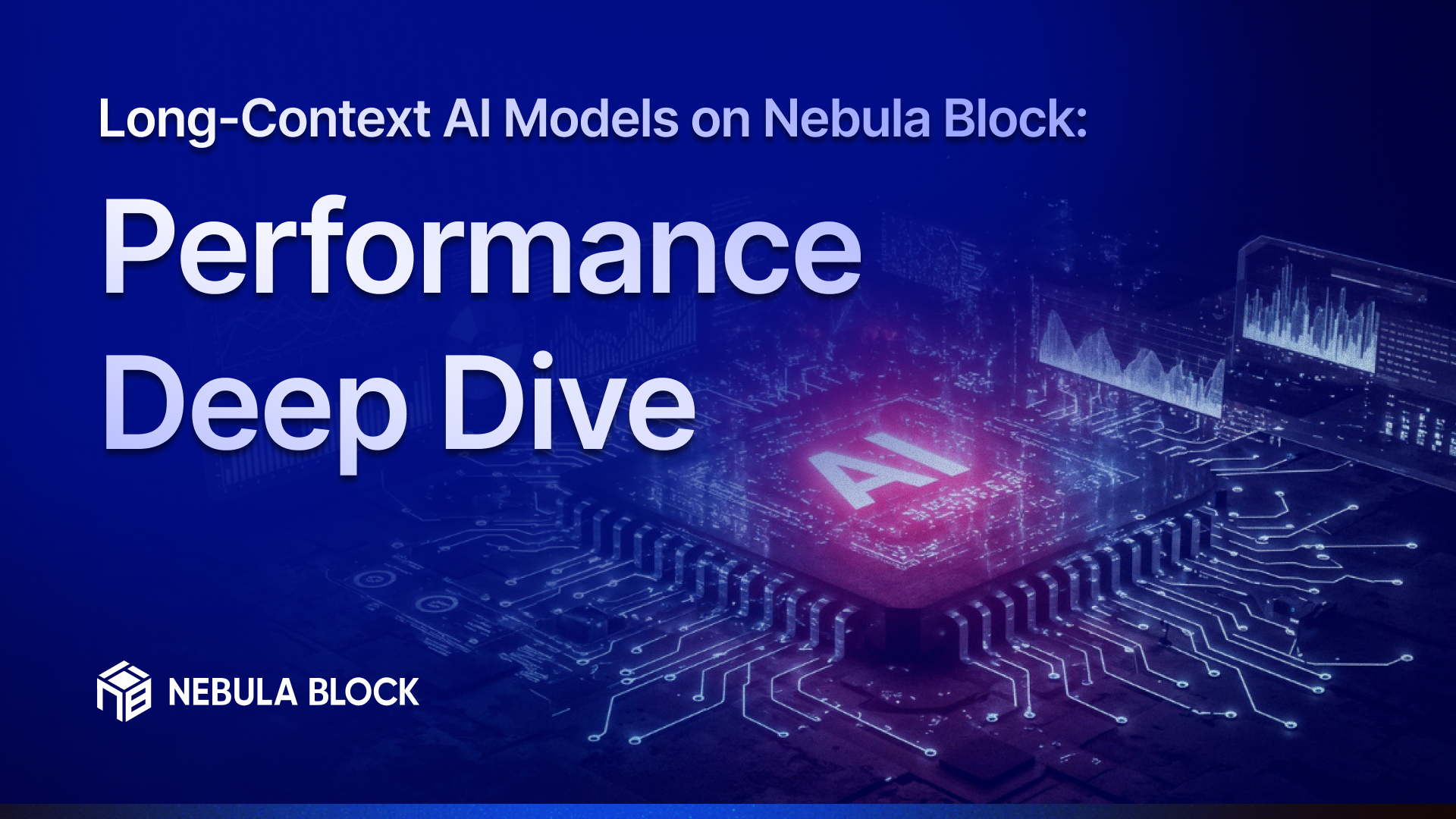Long-Context AI Models on Nebula Block: Performance Deep Dive

As AI applications grow more complex, long-context models like MemAgent, LongMem, and DeepSeek R1 have become essential for tasks requiring sustained memory and deep understanding.
In this article, we explore how Nebula Block’s infrastructure is specifically optimized to support these models — focusing on GPU memory, bandwidth efficiency, and token limit handling.
What Are Long-Context Models?
Long-context models are language models specifically designed to process and retain large spans of text or conversation history. Unlike standard models that might lose track of earlier inputs, these are engineered to maintain context across lengthy documents, complex dialogues, or multi-step reasoning tasks.
🔍Use Cases for Long-Context Models:
- Conversational agents requiring memory of past interactions
- Legal or medical document analysis
- Retrieval-augmented generation (RAG)
- Long-form content generation and summarization
🧠Examples of Long-Context Models
- MemAgent
Maintains a persistent memory across conversations, allowing an AI to retain facts, preferences, or a consistent personality over time. Ideal for customer support bots, AI companions, and interactive storytelling. - LongMem
Specializes in processing long data sequences and complex dependencies. It excels at managing extended interactions, historical context, or analyzing lengthy documents in a single pass. - DeepSeek R1
Optimized for high-performance data retrieval and search. Its powerful context-length capabilities allow it to navigate and synthesize information from massive data corpora with exceptional speed and precision.
Infrastructure-Level Optimizations at Nebula Block
1. High-VRAM GPU Instances
To support long-context reasoning, models must hold large amounts of contextual data in active memory. Nebula Block offers:
- NVIDIA H100 & A100: Up to 80 GB HBM — Perfect for running large models and retaining full history during inference.
- RTX 6000 Ada: Cost-efficient for lighter workloads.
- B200: Designed for ultra-heavy workloads requiring massive memory and compute — ideal for long-context inference, multi-agent orchestration, and large-scale training.
This capacity enables smooth training, fine-tuning, and deployment of long-context models — without sacrificing throughput or accuracy.
2. High Bandwidth and Low Latency
Long-context inference requires high-speed access to memory, especially for real-time applications:
- Up to 2 TB/s bandwidth on H100; 8 TB/s on B200.
- High-speed interconnects (e.g., PCIe, NVLink where available) enable efficient multi-GPU communication.
- Low-latency pipelines: Optimized for retrieval-augmented generation and multi-agent workflows.
This architecture minimizes bottlenecks and accelerates context-aware reasoning.
3. Advanced Memory Management
Efficient memory allocation is critical for multi-turn tasks and long-sequence processing.
- Dynamic memory allocation: Adjusts usage based on model behavior and input size.
- Garbage collection: Prevents memory leaks and fragmentation during long-running sessions.
- Session-aware memory pooling: Reuses memory across batched requests to reduce latency.
These techniques ensure stability and responsiveness even under heavy concurrent load.
4. Smart Token Management
Even long-context models have token limits (e.g., 32k–128k), which must be managed intelligently.
- Preprocessing support: Chunking, summarization, and context prioritization.
- Adaptive context windowing: Maintains relevance across sessions, ideal for memory-based agents like MemAgent.
- Token-aware routing: Ensures high-value inputs are prioritized during inference.
This keeps models efficient and responsive, even with massive input sequences.
5. Scalability and Multi-Instance Flexibility
Nebula Block scales effortlessly to meet growing demand and parallel workloads.
- Auto-scaling compute: Dynamically adjusts resources based on real-time usage.
- Multi-Instance GPU (MIG): Serve multiple models or users from a single GPU.
- Containerized deployment: Supports isolated environments for agents, RAG pipelines, or fine-tuning jobs.
Whether you're building a chatbot or batch-processing documents, Nebula Block adapts without compromise.
✅Summary of GPU Specifications
To assist in decision-making regarding which GPU to utilize for long-context models, here is a summary table of relevant specifications:
| Specification | NVIDIA H100 | NVIDIA A100 | RTX 4090 | RTX 5090 | B200 |
|---|---|---|---|---|---|
| VRAM | 80 GB HBM3 | 40 or 80 GB HBM2 | 24 GB GDDR6X | 32 GB GDDR7 | 192 GB HBM3e (96×2) |
| Memory Bandwidth | 2 TB/s | 1.6 TB/s | 1008 GB/s | 1792 GB/s | 8 TB/s |
| FLOPS (FP32) | 67 TFLOPS | 19.5 TFLOPS | 82.58 TFLOPS | 104.8 TFLOPS | 124.16 TFLOPS (62.08×2) |
| CUDA Cores | 14,592 | 6,912 | 16,384 | 21,760 | 33,792 (16,896×2) |
| Power Consumption | 350 W | 400 W | 450 W | 575 W | 1000 W |
Note: Specifications based on NVIDIA public data and internal benchmarks as of July 2025.
Conclusion
Deploying long-context models such as MemAgent, LongMem, and DeepSeek R1 requires much more than raw model performance. The underlying infrastructure — from VRAM to token handling — plays a defining role in delivering consistent, high-quality results.
Nebula Block: Canada’s First Sovereign AI Cloud
Nebula Block is the first Canadian sovereign AI cloud, designed for performance, control, and compliance. It offers both on-demand and reserved GPU instances, spanning enterprise-class accelerators like NVIDIA B200, H200, H100, A100, and L40S, down to RTX 5090, 4090, and Pro 6000 for cost-effective experimentation. Backed by infrastructure across Canada and globally, Nebula Block supports low-latency access for users worldwide. It also provides a wide range of pre-deployed inference endpoints—including DeepSeek V3 and R1 completely free, enabling instant access to state-of-the-art large language models.
At Nebula Block, we’ve engineered our platform to meet these demands with:
- High-VRAM, low-latency GPU instances
- Smart memory and token management
- Scalable, adaptive resource allocation
Whether you're pioneering long-form reasoning, building interactive agents, or deploying document-level RAG, Nebula Block provides the rock-solid foundation you need to build with confidence—and scale without compromise.
Next Steps
Sign up and run your own model.
🔍 Learn more: Visit our blog and documents for more insights or schedule a demo to optimize your search solutions.
📬 Get in touch: Join our Discord community for help or Contact Us.
Stay Connected
💻 Website: nebulablock.com
📖 Docs: docs.nebulablock.com
🐦 Twitter: @nebulablockdata
🐙 GitHub: Nebula-Block-Data
🎮 Discord: Join our Discord
✍️ Blog: Read our Blog
📚 Medium: Follow on Medium
🔗 LinkedIn: Connect on LinkedIn
▶️ YouTube: Subscribe on YouTube